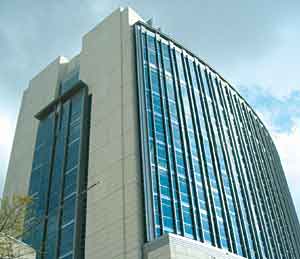Exploring the High-Performance Benefits of Laminated Glass
Ballistic Protection
In addition to withstanding the blows of a variety of objects during an attempted burglary, laminated glass offers protection against ballistic (bullet) attack. In specific ballistic configurations, laminated glass can reduce the risk of injuries from a ballistic attack without compromising the complete visual clarity afforded by a glass system. It can also resist penetration by high-velocity ballistics when constructed in multiple alternating layers of glass and interlayers.
|
|||||||||||||||||||||||||||||||||||||||||
UL test 752 tests the ability of glazing to withstand penetration by various classes or levels of firearms. In order to pass certification for a certain level, the projectile (bullet) must not penetrate the glazing and must not result in large fragments of glass being forcibly thrown from the witness side of the sample for a distance of 18 inches or more. Based on the UL tests, certain laminate thicknesses are needed to resist specific ballistic impact. Thicker security glazing will exhibit greater resistance to both penetration and glass spall (tiny slivers of glass).
Because of its demonstrated ability to withstand ballistic penetration, laminated glass is often used to provide round-the-clock protection to employees in high-risk facilities such as banks and prison control rooms, which require extreme ballistic protection and complete visual clarity.
Blast Resistance
Several of the survivors of the September 11, 2001 Pentagon attack credit blast-resistant laminated glass with saving their lives. The impacted section of the building had just been renovated for security upgrades, which included windows manufactured with a laminated glass component. After the explosion, these windows remained in the frames, providing building occupants protection from flying glass shards.
|
Experts at Texas Tech Glass Research and Testing Laboratory estimate that approximately 75 percent of all damage and injury from bomb blasts can be attributed to flying and falling glass following an explosion. They note that a single square foot of unprotected glass can project as many as 100 sharp shards of glass flying at speeds of up to 300 feet per second. Laminated glass provides passive protection and can mitigate the effects of a blast in several ways. Most importantly, it protects people, both within the targeted building and in the surrounding area and structures. Because laminated glass stays within its frame during the initial blast wave and when impacted by flying debris, it reduces or eliminates flying glass to prevent injuries, and provides protection against flying debris. The glass also protects the building, reducing collateral damage, opportunity for looting, and costs to repair the targeted and surrounding buildings. The performance of laminated glass is often compared to ordinary monolithic glass based on retentivity, or ability to stay in the opening or hold on to glass fragments.
Because of these characteristics, laminated glass meets stringent blast-resistant standards outlined by the U.S. Department of State and the U.S. General Services Administration (GSA), and is used in many federal buildings.










